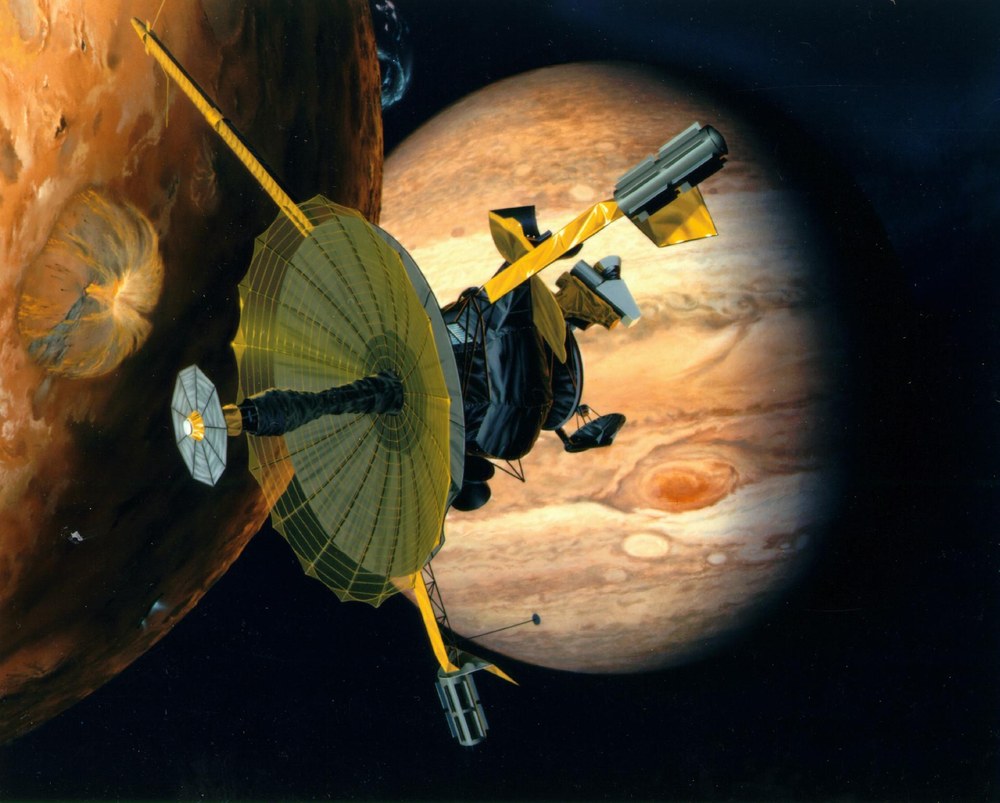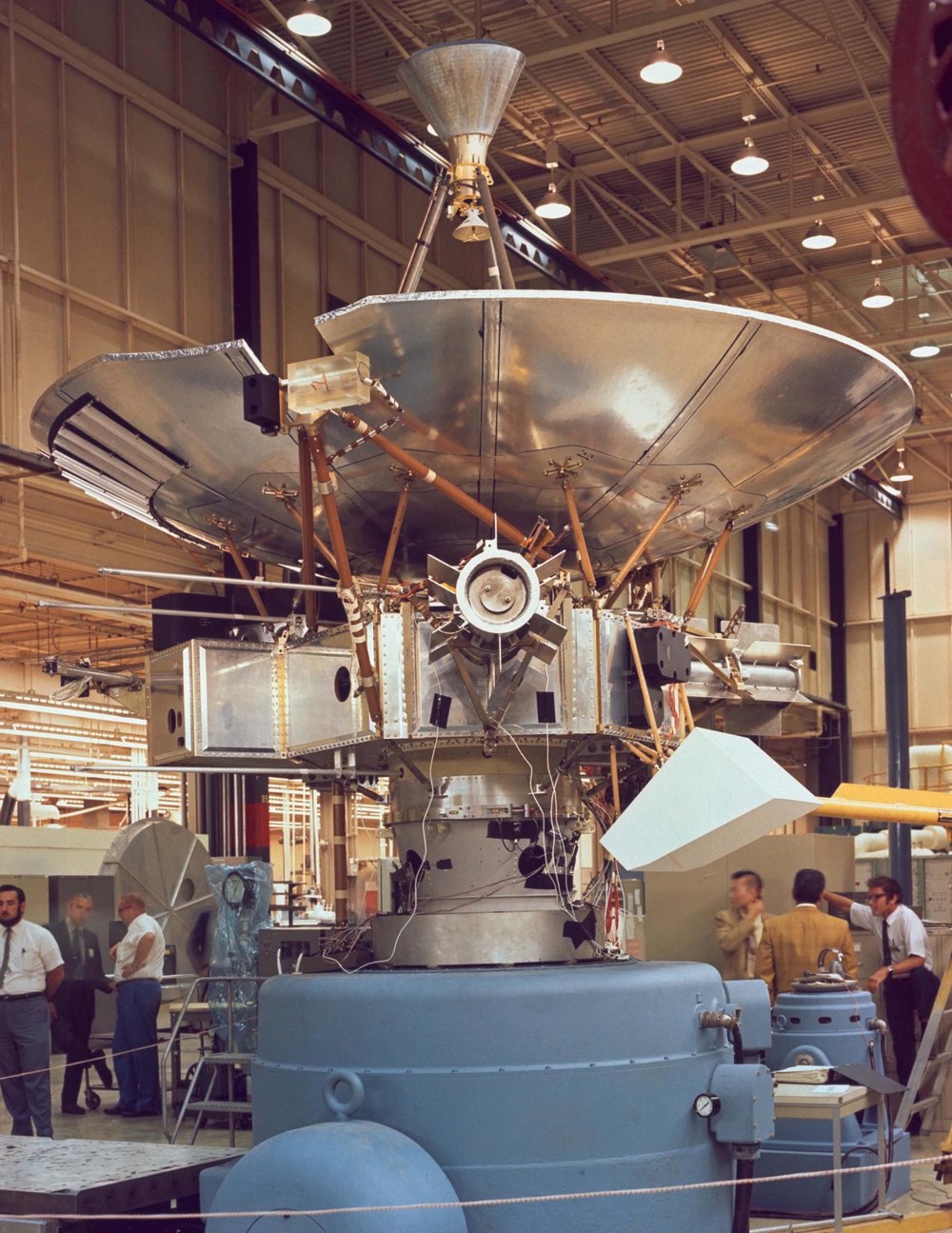Jupiter from a historical perspective and as a target of spacecraft


As the second brightest 'star' in the night sky after Venus, Jupiter, like the other planets visible to the naked eye – Mars, Mercury and Saturn – has always been known to humankind as a 'wandering star': It changes its position against the background of the fixed stars. In 1610, the Italian polymath Galileo Galilei discovered four satellites orbiting the planet with his telescope. This observation contributed significantly to the establishment of the Copernican conception of the world, which had been under dispute since 1543: It is not the Earth but the Sun that is at the centre of our planetary system. The four large moons of Jupiter – Io, Europa, Ganymede and Callisto – were named the Galilean moons in honour of Galileo.
ESA's JUICE mission is the first spacecraft to be steered into orbit around one of Jupiter's moons – in this case, Ganymede. This marks a new stage in the systematic exploration of Jupiter's moons. The Jupiter system has already been explored by spacecraft since the 1970s, and future missions will continue to explore the giant planet and its moons.
With Jupiter as the exploration target, one can differentiate between two types of missions. One serves or served almost exclusively to investigate the largest planet in the Solar System and its moons. The others use Jupiter, due to its large mass, as a 'gravity assist' for the purpose of acceleration to other destinations in the Solar System. The latter group includes the NASA missions Cassini (target: Saturn) and New Horizons (target: Pluto) as well as the ESA mission Ulysses (target: polar solar orbit). The two Voyager and the Pioneer 10 and 11 spacecraft also used Jupiter to perform flybys of Saturn – and in the case of Voyager 2, later also of Uranus and Neptune. However, Jupiter was also a major target of these missions.
Pioneer 10 and 11
NASA's Pioneer 10 and 11 missions were the first ever missions to the outer Solar System. They proved that the asteroid belt between Mars and Jupiter can be traversed safely with spacecraft and that objects in the outer Solar System can be targeted. Pioneer 10 and the identical Pioneer 11 spacecraft reached Jupiter in November 1973 and December 1974, respectively.
With 11 instruments on board, Pioneer 10 and 11 provided important data on the asteroid belt, Jupiter itself and its magnetosphere and radiation belts. The first images of the Galilean moons were also taken during the flyby of the Jovian system. The last data from Pioneer 10 were received on Earth in 2003 from a distance of approximately 12 billion kilometres. Contact with Pioneer 11 broke off in 1995.
Voyager 1 and 2
While Pioneer 10 and 11 were rather technical missions, Voyager 1 and Voyager 2 were the first fully equipped spacecraft to be sent to the outer Solar System. The 11 instruments, with a total mass of 105 kilograms, delivered numerous spectacular results. The first detailed images showed, among other things, the dynamics of Jupiter's cloud structures, the active volcanism on Io, the unique structures of the ice surfaces on Europa, Ganymede and Callisto, as well as Jupiter's ring system.
Launched on 5 September 1978, Voyager 1 reached the Jupiter system as early as March 1979. Only a short time later, in April 1979, the identically constructed Voyager 2 spacecraft arrived in the Jupiter system and continued its investigations. After their Jupiter flybys, both spacecraft reached Saturn in 1980 and 1981, respectively. For Voyager 1, this marked the end of its mission in the Solar System, but it continued its flight and crossed the border into interstellar space in 2012. Due to a unique planetary constellation, Voyager 2 was able to continue its journey with flybys of the Uranus and Neptune systems. Voyager 2 is one of the most successful planetary missions, having flown by all four gas planets.
Voyager 1 is still (as of 2023) sending radio signals and measurement data from four instruments to Earth from the direction of the 'Serpent-bearer' constellation and, at over a distance of 150 astronomical units (22.5 billion kilometres), is the furthest spacecraft from Earth. Voyager 2 will pass the 20-billion-kilometre mark in 2023 and send data to Earth with five active measuring instruments. Radio signals from the two spacecraft need around 18.5 and 22 hours, respectively, to reach Earth.
Galileo
NASA's Galileo mission was the first time an orbiter was sent into the Jupiter system. It was launched on 18 October 1989 from the cargo bay of the space shuttle Atlantis. After arriving at Jupiter in December 1995, Galileo orbited the planet until 2003, performing numerous close flybys of the moons. On its way to Jupiter, Galileo had also observed the more than 20 impacts of the comet Shoemaker-Levy 9, torn apart into kilometre-sized fragments by Jupiter's gravity in July 1994. This was not possible from Earth or with other spacecraft.
The data from the Galileo mission are the most important basis for preparing the JUICE mission. Among other things, Galileo determined the inner structure of the moons. Evidence of oceans in the interior of Europa, Ganymede and Callisto was found, and new insights into Jupiter and its magnetosphere were gathered. Once in Jupiter orbit, the Galileo spacecraft was deployed. Descending on a parachute down to a depth of 160 kilometres below the 1-bar limit, it carried out measurements in Jupiter's atmosphere up to an atmospheric pressure of 22 bar for the first time on site. A surprising result of the Galileo mission was the detection of a self-generated magnetic dipole field at Ganymede.
Despite Galileo's main antenna malfunction, almost all scientific goals were achieved with two mission extensions. Galileo entered Jupiter's atmosphere on schedule in 2003, where it burned up. This ensured that there was no possibility of contamination of Jupiter's moons with biological material from Earth even after the end of the mission.
Juno
NASA's Juno mission, the second orbiter in the Jupiter system after Galileo, has been at the giant planet since 2016 and is currently (as of 2023) in the extension phase, which will last until 2025 at the latest. In the nominal mission, Juno exclusively studied the giant planet itself, particularly its magnetosphere and gravitational field. Juno provided spectacular images of Jupiter's atmosphere, for the first time from a polar perspective.
The spacecraft was manoeuvred into a highly elliptical polar orbit in order to better explore Jupiter's polar regions. On the other hand, this minimised the influence of Jupiter's harmful radiation belts on the spacecraft and its instruments. In the extended mission phase, the spacecraft was placed in a near-equatorial orbit. This enabled flybys of the moons Ganymede, Europa and Io. In 2021, Juno provided data from the Ganymede flyby at an altitude of 1038 kilometres. This was followed in September 2022 by a Europa flyby at an altitude of just 352 kilometres. Two Io flybys will follow in 2023 and 2024 during the extended mission phase.
JUICE and Europa Clipper
ESA's JUICE mission and NASA's Europa Clipper mission will continue systematically exploring the Jupiter system, especially its moons. JUICE will be the first spacecraft to enter orbit around one of Jupiter's moons. Ganymede is the main target of this mission, but flybys of Europa and Callisto will also greatly improve our understanding of Jupiter's moons.
Europa Clipper will remain in Jupiter's orbit but will perform a sequence of more than 40 flybys of Europa to characterise this moon in detail and, particularly, to study its suspected ocean. Both missions will use radar to 'look' beneath the icy surface of these moons to detect liquid water and oceans. The sequence of flybys, rather than an orbit around Europa, will reduce the damaging influence of Jupiter's radiation environment to a level that the spacecraft and instruments can withstand. Europa Clipper will reach the Jupiter system in 2029. A little later, in 2031, JUICE will be steered into orbit around the giant planet. For several years, both spacecraft will simultaneously take measurements in the Jupiter system, which will be particularly useful for studying the dynamic processes at play in Jupiter's magnetosphere.
JUICE and Europa Clipper, with their extensive data sets, will also set the stage for future missions, especially for landing spacecraft. Ideas for on-site measurements to provide access to the oceans are being developed but are not yet concretely feasible at present.
Jupiter as a flyby target
Because of its large mass, Jupiter is typically used to put spacecraft on a faster course to more distant targets in the outer Solar System or to alter their orbit significantly. This procedure was already used successfully with the Pioneer and Voyager spacecraft.
Ulysses
The ESA/NASA mission Ulysses used a Jupiter flyby in 1992 to enter a polar orbit around the Sun. The mission's primary objectives were the exploration of the solar corona, solar wind, solar magnetic field, solar plasma waves and cosmic rays. Measurements were also taken of Jupiter's magnetic field and plasma.
Cassini
The NASA/ESA Cassini/Huygens mission used a Jupiter flyby in 2004 to get on course for the Saturn system and achieve the necessary acceleration. The primary objective of the mission was to study Saturn, its ring system, and numerous moons – in particular its largest moon, Titan, which is almost the size of Ganymede and the second largest satellite in the Solar System. The Huygens lander successfully separated in 2005 and landed on Titan's minus 170 degrees Celsius icy surface after a two-hour parachute flight through the atmosphere.
The main scientific goal of the Jupiter flyby was to record temporal variations in its atmosphere using image data. The interpretation of the observations led to a new understanding of the dynamics in the zones and cloud belts of Jupiter's atmosphere.
New Horizons
In order to get closer to the actual mission target, the Pluto-Charon system, NASA's New Horizons spacecraft also performed a 'swing-by' manoeuvre at Jupiter in 2007. Spectacular images of volcanic eruptions in the polar region of Tvashtar on Jupiter's moon Io were obtained during the flyby just outside Callisto's orbit. Spectrometers were able to detect, among other things, differences in the surface composition of Ganymede, which are presumably due to the shielding of charged particles by Ganymede's magnetic dipole field.
ESA mission with strong German participation
JUICEi s ESA's largest and most comprehensive mission to explore the planets of the Solar System. In addition to ESA , NASA and the Japanese space agency JAXA have also contributed to the mission. ESA is providing funding for the satellite platform, the launch with an Ariane 5 ECA rocket and the operation of the spacecraft. The funding for the scientific payloads for JUICE is largely provided by national space agencies and the participating institutes themselves. In addition to the JANUS, SWI and GALA experiments, the German Space Agency at DLR is funding further German scientific contributions from the National Space Programme with the Particle Environment Package (PEP) particle spectrometer, the Jupiter Magnetometer (J-MAG), the Radar for Icy Moons Exploration (RIME) radar instrument and an instrument for radiosounding Jupiter's atmosphere (3GM).

